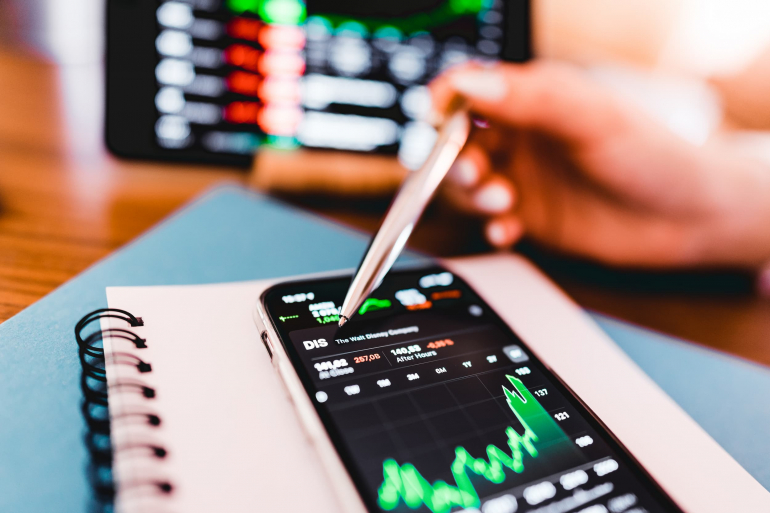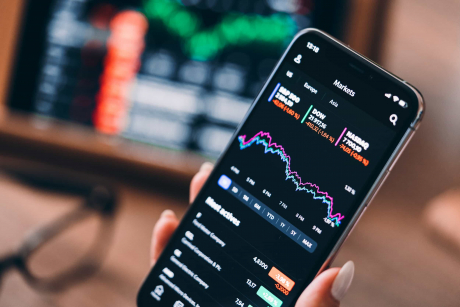Robinhood has totally reshaped how online broker-dealers work, making stock trading available for the masses by offering investors, mainly millennials, commission-free and gamified investing experience. This strategy turned out to be very lucrative bringing in a great deal of lay first-time investors and made a significant amount of money, however, skeptics claim that not everything is as transparent as it should be. So how does Robinhood make money?
By making trading easy, straightforward, and, most importantly, free, Robinhood has become the first-choice app for tons of first-time, inexperienced investors, enabling them to access the stock markets at no cost.
In this article, we'll scrutinize Robinhood’s sources of revenue.

Table of Contents
- How does Robinhood make money?
- What Is Robinhood?
- How Did Robinhood Start?
- How Does Robinhood Work?
- How Does Robinhood Make Money?
- The main Robinhood’s revenue sources are:
- Robinhood Revenue Statistics
How does Robinhood make money?
With a valuation of over $11 billion and 13 million users, Robinhood is one of the leading and top-ranking fintech apps in the world. The Robinhood business model is a freemium model with the main source of income generated from razor-thin margins on massive volumes of individual trades.
Robinhood, a zero-commission investing platform, reported 3 million new accounts in Q2 of 2020, mainly caused by the pandemic shutdown which triggered a surge of young investors to the stock market.
By offering zero trading commission and providing fair shots, Robinhood has revolutionized the brokerage firms market forcing other brokers to abolish trading commissions. Before Robinhood, to open an account, it was necessary to invest a minimum of $500 and each individual investor was charged between $5 and $10 a trade.
Even though Robinhood’s mission to “democratize finance for all” is very noble and high-minded, each company’s existence finally comes down to numbers in the Excel spreadsheet. So how does Robinhood make money?
Let’s look into details of how Robinhood generates the majority of its revenue.
Back to topWhat Is Robinhood?
Robinhood Markets, Inc., headquartered in California, is a retail-oriented online and phone app-based brokerage firm, offering self-directed securities brokerage services. It allows customers to buy and sell securities such as stocks, options, gold, exchange-traded funds (ETFs), and cryptocurrencies without paying a trading commission. Robinhood is a fully licensed broker-dealer since it is not only registered with the US Securities Exchange Commission but also a member of the Financial Industry Regulatory Authority and the Securities Investor Protection Corporation.
Robinhood is perceived as a cutting-edge fintech firm due to its innovativeness, technology-focused background, business offering based on financial services, and groundbreaking approach to charging commission which led to changes in the whole brokerage industry.
Founded by two former Stanford students, the app-based stock brokerage threw down the gauntlet to big stock brokerage firms such as Charles Schwab, Fidelity Investments, E*TRADE, or TD Ameritrade and basically forced them to eliminate fees attached to trading stocks.
Robinhood streamlined the stock trading process by creating an extremely user-friendly app, providing no account minimums and zero trading commissions which opened up trading to a new demographic. This easy-to-use, user-friendly, and well-designed trading app attracted tons of millennials to the trading floor who now account for approximately 20% of stock market activity. With the help of social media and such trading apps like Robinhood, those young investors start to challenge the existing order established by the big market players.
According to Statista, Robinhood's number of users went up steadily since 2014, even though it did not launch until mid-2015. The number of users of the commission-free trading app soared from half a million in 2014 up to 13 million in 2020 which makes Robinhood the fastest-growing stock brokerage in history.
Back to topHow Did Robinhood Start?
Robinhood was founded in 2013 by Vlad Tenev and Baiju Bhatt who met at Stanford. Prior to setting up Robinhood, the former roommates and classmates built two finance companies selling high-frequency trading software to hedge funds. While working in the world of finance in New York, they found out that commission for every trade is charged only from individual Americans in contrast to big Wall Street financial institutions which pay nothing.
Future Robinhood founders wanted to “build products that would provide everyone with access to the financial markets, not just the wealthy'', according to the Robinhood website. They decided to set up a company that allows everybody to take part in the financial market no matter how small their investment funds are by not charging a commission for stock trades. Robinhood’s intention is to facilitate access to financial markets and put retail and institutional investors on the level playing field in terms of trading fees.
Back to topHow Does Robinhood Work?
Prior to Robinhood, investing was complicated, expensive, and time-consuming, and mostly reserved for a small bunch of wealthy investors ready to pay hefty commissions for brokerage services. By launching commission-free investing, Robinhood challenged the status quo of the whole brokerage industry which followed suit Robinhood, implementing a commission free model as well.
Investors who want to begin trading on Robinhood need to apply for an account and provide the broker-dealer with specific personal information. According to the Securities and Exchange Commission (SEC) regulations, all broker-dealers operating in the US are required to collect and verify their users’ personal information, including the investor’s name, address, date of birth, tax identification number, employment status, net worth, annual income, and investment objectives.
Robinhood investors don’t need to provide a valid Social Security Number. They need to be 18 years or older and have a legal U.S. residential address within the 50 states or Puerto Rico. Most importantly, the Robinhood app is available only to U.S. citizens, U.S. permanent residents, or those who have a valid U.S. visa.
Before the pandemic, the Robinhood team had plans to launch the app in the UK, however, the global expansion has been delayed indefinitely due to US lawmakers' scrutiny in its home market.
The verification process may take up to one week, however, most applications are processed much faster. Additionally, future investors need to connect their bank account with their Robinhood brokerage account to enable funds transfers.
Back to topHow Does Robinhood Make Money?
Considering that both setting up an investment account and trading securities entail no additional costs, this leads us to the question of how Robinhood actually makes money?
Even though Robinhood intends to win a bigger fintech market share, the main current sources of Robinhood’s revenue are razor-thin margins made on high-volume, high-frequency trading and Robinhood Gold, which is a premium membership service.
Back to topThe main Robinhood’s revenue sources are:
Payment for order flow
To execute customer orders, Robinhood, just like other retail broker-dealers, routes them to market makers or high-frequency trading firms, instead of sending them directly to national exchanges. Since Robinhood’s launch, the company has received payment, typically fractions of a cent, for routing its customers' orders to market makers. While this practice, known as payment for order flow, is considered controversial, is widely used by other online brokerages as well. The market maker pays Robinhood — typically, fractions of a cent — for those orders. Eventually, the market maker or HFT firms execute the trade profiting on the difference between securities’ prices known as the bid-ask spread.
According to Bloomberg, “The startup, valued at $5.6 billion, was bringing in more than 40 percent of its revenue earlier this year [2018] from selling its customers’ orders to high-frequency trading firms, or market makers, like Citadel Securities and Two Sigma Securities.” The magazine notices Robinhood uses the most controversial practice on Wall Street, building its unique selling proposition around the idea of a steal-of-the-rich ethos.
Not only does Robinhood leverage payment for order flow as a source of revenue, but other brokerage firms such as E-Trade or Charles Schwab capitalize on this business model, but much less than Robinhood. While Robinhood makes almost half of its revenue from payment for order flow, in the case of Charles Schwab and E*Trade, it is 3% and 17%, respectively.
Due to this process, both of these parties’ needs are met. Robinhood doesn’t need to deal with intricacies of trades execution and market makers and high-frequency trading firms take advantage of access to massive volumes of trades.
According to the Securities and Exchange Commission, market makers have more processing power and more information than retail brokers and traders, which makes them ideal intermediaries for controversial high-frequency and high-volume transactions.
Market makers are legally obliged to “provide the best possible quality of execution of each trade,” according to the SEC. However, most importantly, they are not required to deliver the best possible price for their clients which can lead to executing trades at prices that are remunerative for the market makers, but not for traders.
According to A Letter From Robinhood Co-Founder & Co-CEO Vlad Tenev, Robinhood earns just approximately $0.00026 in rebates from the market maker per dollar traded which accounts for 2.6 cents in the trade worth $100, however, taking into account the number of trades which are processed by the app daily, the overall value of this income source is significant.
Robinhood earns money out of each individual trade so it is clear the company wants to attract as many investors as possible and encourage them to trade as often as possible since making even small amounts of money on razor-thin margins due to economies of scale may result in significant revenue.
The Robinhood’s overdependence on revenue from payment for order flow brought about legal setbacks, including a fine of $1.25 million for “best execution violations” from the Financial Industry Regulatory Authority (FINRA) in 2019 and the SEC investigation for Robinhood’s negligence to divulge its relationships with market makers until 2018. The company is threatened with fines of up to $10M.
Robinhood Gold membership fees and margin lending
The second Robinhood’s primary source of revenue is the subscription-based service, known as Robinhood Gold, which costs a flat fee of $5 monthly, providing investors with access to premium features, for instance, margin loans. Premium traders can boost their investing power by borrowing money from Robinhood.
To invest on margin, investors need to “pay 2.5% yearly interest on any margin used above $1,000,” according to the Robinhood website. Users don’t need to pay interest on the first $1,000 of margin as it is included in the $5 fee.
Upgrading to Robinhood Gold provides premium users with instant access to borrowing on margin. This feature lets Robinhood users, in particular bargain hunters, seize investing opportunities for greater potential gains (or losses), purchasing undervalued stocks without having the financial resources on hand. In order to borrow money on margin, investors need to deposit at least $2,000, according to the Financial Industry Regulatory Authority (FINRA).
Apart from margin loans, Robinhood Gold offers several other extras next to the “freemium account”, including:
-
Bigger instant deposits
The standard Robinhood account provides access to $1,000 in instant deposits, regardless of the value of the users’ account, whereas Robinhood Gold users get larger instant deposit amounts and can use their funds immediately. Since their buying power is increased, they can seize unexpected opportunities in the market as they don’t need to wait up to five days for their money to clear.
-
NASDAQ Level II Market Data
Robinhood Gold members have access to Level II Market Data which offers extended real-time information on market orders outside of basic bid, ask, and market prices. However, this tool can’t be a single source of information as it doesn’t show all orders, but only those on the Nasdaq stock market.
According to DayTrading.com, by showing more than just best ask and best bid on the market, Level II Market Data provides “the full depth of orders, including aggregated quantities at the individual bids and asks,” which helps traders estimate the desire or availability of a particular stock at a certain price.
-
Professional research reports
By partnering with Morningstar, an investment research company, Robinhood offers premium members unlimited access to updated, in-depth, and comprehensive research reports on 1,700 stocks, reflecting the company’s current business situation.
Morningstar frequently publishes insightful reports referring to the company’s business model, strategy, risk, fair market value, or important company events, such as mergers, new product launches, or a change in leadership. Due to consistent insights based on professional ratings and analysis, Robinhood Gold members can learn how professionals view a company’s outlook, and consequently, make more well-grounded investment decisions.
Commercial banking products
Checking and savings accounts - canceled
Robinhood doesn’t want to be limited by online brokerage business and has taken some steps to expand into other markets as fintech or neobanks.
After revolutionizing the brokerage market, Robinhood has some plans to break into the larger financial services market. In 2018, Robinhood proposed a zero-fee checking and savings account with a 3% interest rate, nailing down traditional banks which offered average interest rates ranging from 0.10-0.21% at the time of the announcement, according to TechCruch. In case of success, the broker-dealer would have transformed checking and savings accounts, putting the squeeze on the biggest financial institutions such as Chase or Bank of America.
However, Robinhood never implemented checking and savings accounts due to deposit insurance issues. Deposits were supposed to be ensured by the Securities Investor Protection Corporation (SIPC) instead of the Federal Deposit Insurance Corporation (FDIC), but the SIPC insurance covers deposits placed in brokerage accounts for the sole purpose of buying securities while Robinhood’s checking and savings users weren’t obliged to trade stocks. The SIPC didn’t give the app the green light so Robinhood pulled back from Checking & Savings.
The checking/savings implementation setbacks didn’t discourage the free stock trading app to proceed seeking more opportunities for launching other commercial banking products.
Cash Management
With the goal in mind to grow the product offerings, Robinhood launched, very similar to Checking & Savings, the Cash Management account with no fees and a free debit card, whose users can pay bills, buy groceries, or get their paychecks.
Cash Management isn’t a separate account, but an added feature to the brokerage account that enables investors not only to earn 0.30% annual percentage yield (APY) on uninvested funds reallocated from the brokerage account to the program banks but also makes them available on demand for everyday spending. Account holders are also offered a customizable debit card, issued by Sutton Bank, that can be used everywhere Mastercard is accepted.
Cash Management accounts, implemented in 2020 and guaranteed by the FDIC, offer annual percentage yield (APY) accounting to 0.30% which is much more aligned with the rates provided by most commercial banks and less juicy than the 3% interest rate designed for Checking & Savings.
How Robinhood makes money from Cash Management?
By eliminating brick-and-mortar branches and making everything digital, Robinhood has managed to reduce its overhead to the minimum so it doesn’t charge customers any maintenance fees, account opening fees or foreign transaction fees, passing the value back to customers.
With Cash Management, Robinhood makes money by collecting fees paid by program banks for reallocating funds to them. Additionally, the app also collects an interchange fee from Sutton Bank, its debit card issuer, which receives it and passes it to Robinhood. Ordinarily, debit and credit card issuers earn interchange fees that cover the costs like fraud loss or transaction processing.
Income from Cash
To generate additional income, Robinhood deposits uninvested funds that aren't transferred to the Cash Management program banks in interest-bearing bank accounts.
Back to topRobinhood Revenue Statistics
Robinhood generated $111 million, and $673 million in payment-for-order-flow revenue in 2019 and 2020, respectively which was a 514% surge year-on-year. According to the latest SEC regulatory filing, Robinhood generated $331 million in payment for order flow in the first quarter of 2021 with $198 million coming from options trading and $133 million coming from equity trades.
In January 2021, Robinhood was a main player in the GameStop squeeze. Restricting the trading of GameStop stocks for a few days made its users angry who interpreted this behavior as market manipulation leveled at helping the hedge funds.
Despite the turmoil, the number of downloads of the Robinhood app reached around 3.29 million, jumping by over five times in January 2021 compared to December 2020, according to Statista. Consequently, the mobile app added $3.4 billion to its balance sheet due to the GameStop stock squeeze, which generated lots of free publicity among young investors who noticed a great opportunity to make money.
Conclusion
The 13-million users app has caused a lot of disruption in brokerage and financial markets, traditionally very difficult to break into. In the face of the forthcoming Robinhood IPO, the company is likely to receive a lot of free publicity and buzz around its brand.
Going public may generate media coverage, increase the prestige and create a reliable image in the eyes of the whole fintech and financial markets which may additionally entice new users to open brokerage accounts. Successful IPO will enhance Robinhood’s brand recognition and visibility, driving numbers of app users and profits up even higher.
Back to top






Comments